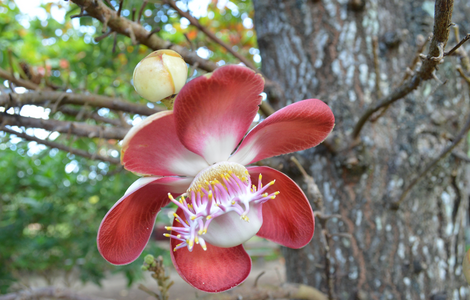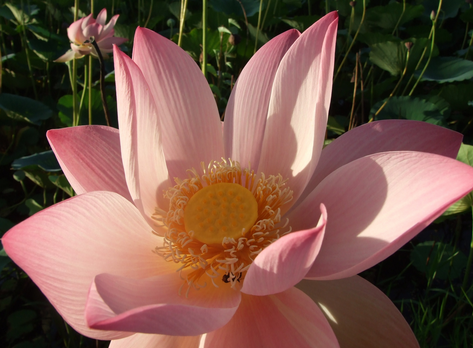Even the Plants are Awesome in Guyana
October 4, 2019 - 12 minutes read If you’ve ever been asked why you love Guyana, its rich, diverse culture, hospitable people and of course its exotic wildlife come to mind, but what about its floral landscape? Guyana boasts one of the most impressive collections of flora on the planet.
If you’ve ever been asked why you love Guyana, its rich, diverse culture, hospitable people and of course its exotic wildlife come to mind, but what about its floral landscape? Guyana boasts one of the most impressive collections of flora on the planet.
From the coastal plains, interior savannahs, forested highlands and hilly, sand and clay areas, a massive 80% of Guyana’s landscape is covered with unspoiled rainforests and flora. This translates to over 8000 different species of plants. Of these, hundreds are put to use in cultural settings, medicine and job creation. An even higher number play an integral role in preserving and maintaining the ecosystem. So on your next trip, make it a point to experience Guyana in bloom, a natural seasonal phenomenon that proudly screams, “Is we own!” A few favorite species are profiled below.
The Cannonball Tree (Couroupita Guianensis)
The name of this towering tree is as unorthodox as the striking features it embodies. It reaches up to 110 feet high with leaves as big as 12-22 inches long. It’s massive, 10 inch spherical fruits resemble rusty cannonballs of which they take their name. When they fall, they hit the ground bursting with a thundering sound reminiscent of a cannon firing. What’s even more intriguing about this strange tree is that the fruit develops straight out of the trunk. The flowers are just as striking with a salmon-red color, developing in enormous bunches up to 12 feet long along the trunk of the trees. The sweet smell of the flowers attract birds and other pollinating insects that feed on its nectar.
When mature, the fruits possess an unmistakable stench with bountiful antibiotic, antifungal and antiseptic benefits. The fruit pulp, in addition to the juice extracted from the leaves and the bark, aids in the treatment of wounds, skin infections, colds and malaria. The hard shells of the fruits are traditionally used as containers.
If you’re interested in exploring these natural wonders, several cannonball trees can be spotted along Brickdam, Georgetown. One, outside of the St. Mary’s School on Brickdam, is over 100 years old. There’s also one standing as proud as ever in the Botanical gardens.
Sacred Lotus (Nelumbium)
Lush pink and white lotuses overflow in the trenches along Guyana’s coastland especially during the rainy season, creating a vivid portrait of color and beauty. Over a period of three days, the blossoming lotus flower rises above the water to unveil its beautiful petals, which in the evening, close and withdraw beneath the surface. No matter how murky the water is, the lotus always emerges flawless and beautifully intact. Known as the Sacred Lotuses in both Hinduism and Buddhism, these plants represent purity, divinity, and are widely recognized as a symbol of life, fertility and ever-renewing youth. They are popularly used in religious practices and rituals – weddings, blessings, offerings and spiritual decor. The leaves of this lotus are also used in Indo-Guyanese culture when serving the famous 7-curry dish (7 different kinds of curry) prepared for religious and other special gatherings.
This is arguably the holiest flower for the Hindus. They revere it with the divinities Vishnu and Lakshmi who are often portrayed on a pink lotus iconography. Brahma (the Creator),Vishnu (the Protector) and Shiva (the Merger) are all associated with this plant. Ancient Hindu teachings suggest that the lotus arose from the navel of Lord Vishnu and at the center of the flower sat Brahma. For Hindus, the lotus represents the belief that within each human, the spirit of the sacred lotus lives.
Giant Water Lily (Victoria Amazonica)
The Victoria Amazonica lily, the National flower of Guyana – is the largest water lily in the world with leaves spanning more than three meters across with thick stalks submerged 7-8 meters in water. When the flowers first bloom at night, they are white and open. On the second night, they become pink. These flowers can grow up to 40 centimeters in diameter and are usually pollinated by beetles.
The Victoria Amazonica is not only known for its amazing stature, it also embodies a rather intriguing story steeped in mysticism and lore. The legend, as adapted by Guyanese author Odeen Ishmael, suggests that in a little village off the river banks of Guyana, lived 12 curious little girls. Every single night, they tried to touch the moon, but they were always unsuccessful. One girl, Neca was as determined as ever and longed to become as beautiful as the moon goddess. One night while the other girls were asleep, Neca saw the bright moon towering over the trees along the river bank and decided that she’d finally be able to touch it. She dived into the water, with hopes of finally reaching the moon only to end up disappearing beneath the deep still waters and drowning.
The moon goddess witnessing this decided that she wanted to immortalize Neca’s memory. The moon goddess brought Neca’s body from the depths of the river and transformed her into a large majestic water lily. That lily is known today as the Victoria Amazonica.
Whenever you’re in Guyana, you can spot this beauty along the shallow waters of the Amazon River basin, such as oxbow lakes and bayous of the Rupununi River. This natural spectacle can also be seen in the ponds around Rewa’s Grass Pond and Karanambu Ranch in central Rupununi.
Greenheart (Chlorocardium Rodiei)
Greenheart has garnered the reputation of being the strongest and most durable wood in the world. What’s even better is that Guyana has the distinction of claiming it as its own. Found in the pristine rainforests among a multitude of other stately trees, the greenheart tree grows between 50-130 feet tall. It’s trunk is approximately 1-2 feet in diameter. It possess extremely large leaves and can be identified by the size and distinctively textured feel. It’s wood ranges from light-green to dark olive green with brown or black markings. Uniquely, it is almost completely immune to decay, water resistant, and highly resistant to marine organisms and fire. Due to the durability, it has been harvested as commercial timber since the late 18th century.
The greenheart tree can be found throughout Guyana’s rainforests in places such as the rainforests of Iwokrama International Centre for Rainforest Conservation and Development, usually on rich soils, in swamps and in the alluvial flats, marshes and uplands of the Amazon Basin. These rainforests, including the greenheart species, support over half of the plant and wildlife of Guyana which are considered to be the world’s oldest ecosystems.
Crabwood tree (Carapa Guianensis)
Carapa Guianensis, commonly known as Crabwood, is found mainly in the rainforest canopy, predominantly along rivers, on periodically flooded or swampy locations, and on the low hills of the hinterland. If you’re in Guyana and interested in seeing one of these beauties up close, just check along the marshlands of Barima/Waini in Region 1, the Pomeroon/Supenaam in Region 2, and at Iwokrama and Mabura. This tree reaches up to 180 feet tall and is valued for its mahogany-like quality wood – which is one of the most expensive types of wood found in Guyana. It produces high quality furniture, flooring and plywood.
There are also health benefits that stem from this tree. It’s seeds are used in the production of what is locally known as crab oil that is used in a number of different ways. From mosquito repellant, hair oil treatments, skin treatments and even as a laxative, this oil is valued among Guyanese. This led to the Guyana Marine Turtle Conservation Society (GMTCS) facilitating the processing and sale of the seeds of the Crabwood tree to benefit coastal communities. This positive and successful venture generates income for the locals and provides an incentive to conserve the trees. The people of Waini now harvest the seeds during the two seasons annually and sell the oil to the North West Organics Company (NWOC) formed by the conservationists of the GMTCS. Bina Hilla Shop and the Rock View gift benabs are retailers of this oil in the North West and Rupununi districts of Guyana.
There is so much more to Guyana’s vast floral landscape. From the exotic orchids, heliconias, carnivorous sundews, delicate maidenhair ferns to the dramatic staghorn ferns and thousands of other species, Guyana’s floral landscape is an attraction in and of itself.
Travel Better with Guyana: Guyana is working hard to conserve its vibrant wildlife and ecosystems and protect its culture and heritage. We realize that it is often difficult to understand how you can support these aims and make a difference when you travel. That’s why we’ve set out to help you by creating Visitor Guidelines For Sustainable Travel. All passionate globetrotters, curious culture seekers and bold adventurers are encouraged to do all they can to leave a positive impact on the people and places you visit in Guyana.
Tags: cannonball trees, Flora of Guyana, Flowers of Guyana, Giant Water Lily (Victoria Amazonica), Rainforest flowers, Sacred Lotus (Nelumbium)




0 Comments